Urban Electric Vehicle Fast-Charging Demand Forecasting Model Based on Data-Driven Approach and Human Decision-Making Behavior
Abstract
1. Introduction
- (1)
- This study applies Didi trip order data to the field of EV charging demand prediction. Through the data-driven technology, the actual traffic operation characteristics and rules are obtained, which addresses the problem of lacking measured data in the research for electric vehicle interaction with the power grid and traffic network. Compared with the simulation modeling methods, the accuracy of EV charging demand prediction is improved;
- (2)
- The human behavior decision-making model is utilized to analyze aggregated charging and driving behavior. Furthermore, the decision-making model discusses the dominant role of owners in the interaction system and is more in accordance with their subjective psychology and selection features;
- (3)
- The spatio-temporal distribution characteristics and influencing factors of charging demand for urban fast-charging stations are comprehensively investigated, which provides support for subsequent charging guidance and impact assessment.
2. Fusion Architecture of ‘Electric Vehicles–Power Grid–Traffic Network’
3. Mining and Fusion of Online Ride-Hailing Trip Data
3.1. Data Description
3.2. Data Pre-Processing and Visualization
3.3. Data Mining and Fusion Modeling
3.3.1. Trip Range Screening
3.3.2. Spatial Grid Modeling
3.3.3. Trajectory Data Mapping
3.3.4. POI Retrieval Data Identification
3.3.5. Urban Functional Area Clustering
3.3.6. Traffic Network Modeling
3.3.7. Driving Route Statistics
3.4. Data Mining and Fusion Results
3.4.1. Functional Area Selection
3.4.2. Temporal Distribution of Trip Rules
3.4.3. Spatial Distribution of Trip Rules
3.4.4. Actual Driving Routes
4. Single Electric Vehicle Model
4.1. Types and Quantities of EVs
4.2. Driving Behavior Modeling
- (1)
- Ev(i) is assigned departure time , departure position and destination position from OD sets and by Monte Carlo random sampling.where i represents the serial number of one EV, , .
- (2)
- The route with the most frequent usage between OD point is selected as the initial planned route for Ev(i).
- (3)
- When the charging requirement is not triggered, the initial planned route is the actual driving route . Otherwise, the triggering time and triggering location are recorded, and the destination location is changed to the recommended charging station location . k denotes the serial number of fast-charging stations, , . After completion of charging, the destination position is changed to , and the actual driving route is expressed as .where indicates the mark of vehicle charging requirement; when it is triggered , otherwise . indicates the moment when one vehicle arrives at a recommended fast-charging station, indicates the moment when one vehicle leaves a fast-charging station, and indicates the moment when one vehicle finally arrives at its destination.
- (4)
- Thus, each vehicle’s driving time consumption and distance on the entire traffic network are expressed as follows:where represents the road segment distance of actual driving route between position x and position y.
- (5)
- When Ev(i) arrives at its destination, the above steps are repeated to extract a new original departure and return matrix, and the simulation of tracking the vehicle trip trajectory is completed all in a day.
4.3. Charging Behavior Modeling
4.3.1. Battery Parameter Setting
4.3.2. Power Consumption Per Unit Kilometer
4.3.3. Charging Requirement Judgment
4.3.4. Fast-Charging Station Model
5. Human Behavior Decision-Making Model
5.1. Basic Principle of Regret Theory
5.2. Fast-Charging Station Recommended Model
6. Electric Vehicle Fast-Charging Demand Forecasting Model
- (1)
- Mine and fuse Didi order data to obtain the characteristics and rules needed for residents’ trip demands;
- (2)
- Use the above statistical rules and regenerative data as the basis for the EV driving behavior model, and establish a single EV charging behavior model;
- (3)
- Consider a behavior decision model with time consumption and charging cost to plan the route and recommend the fast-charging station for EV owners;
- (4)
- Calculate the charging demand of the fast-charging station and evaluate the charging load operating characteristics in different scenarios.
7. Path Planning Experiments
8. Case Studies and Analysis
8.1. Temporal–Spatial Distribution of Fast-Charging Demand Load
8.2. Fast-Charging Demand Load with Different Path Strategies
8.3. Fast-Charging Demand Load with Different Charging Modes
8.4. Fast-Charging Demand Load with Different Charging Facility Ratios
8.5. Utility Evaluation of Human Behavior Decision-Making Model
9. Conclusions
Author Contributions
Funding
Acknowledgments
Conflicts of Interest
Abbreviations/Nomenclature
| EV | Electric vehicle |
| FCS | Fast-charging station |
| OD | Origin Destination |
| POI | Point of Interest |
| AP | Actual path |
| SLP | Shortest length path |
| STP | Shortest time path |
| Sets | |
| Trajectory data set for the jth order | |
| Set of starting point | |
| Set of ending point | |
| V | Set of traffic nodes |
| E | Set of sections in a traffic network |
| W | Set of road segment weights |
| Set of traffic nodes for the jth order trip trajectory | |
| The mth route between OD point | |
| Initial planned route | |
| Actual driving route | |
| Parameters | |
| G | Traffic network |
| Charging station location | |
| Mark of charging requirement | |
| Driving distance | |
| Road segment distance | |
| Battery capacity | |
| Initial battery capacity | |
| Remaining battery capacity at time t | |
| Range anxiety coefficient | |
| Number of charging piles | |
| Utilization rate of charging facilities | |
| Charging efficiency | |
| Charging power of charging pile | |
| Time-of-use price of charging services | |
| Estimated parameter | |
| Attribute values | |
| Variables | |
| Latitude and longitude coordinates of departure point | |
| Latitude and longitude coordinates of arrival point | |
| Starting time | |
| Arriving time | |
| Triggering time of charging requirement | |
| Triggering location of charging requirement | |
| Destination location | |
| Moment arriving at the FCS | |
| Moment leaving the FCS | |
| Moment arriving at the destination | |
| Driving time consumption | |
| EV per-unit kilometer power consumption in different grades traffic roads | |
| Average velocity | |
| Decision variable of road sections | |
| Average arrival rate | |
| Average service rate | |
| Idle probability of one charging pile | |
| Average queue length | |
| Average charging waiting duration | |
| Charging waiting duration | |
| Number of vehicles at station | |
| Serial number of charging piles | |
| Charging duration | |
| Finishing charging SOC value | |
| Battery capacity of a vehicle arriving at FCS | |
| Charging cost | |
| Random regret value | |
| Determined regret value | |
| Random regret error | |
| Probability of chosen scheme | |
| Fast-charging demand load | |
Appendix A
| Field Name | Field Type | Field Description |
|---|---|---|
| Vehicle ID | Varchar | Anonymized |
| Order ID | Varchar | Anonymized |
| GPS instantaneous time | Datatime | Format yyyy/mm/dd hh: mm: ss |
| Trajectory GPS longitude | Double | Format dd.dddd, GCJ-02 coordinate system |
| Trajectory GPS latitude | Double | Format dd.dddd, GCJ-02 coordinate system |
| Trip distance | Double | Format dd.dddd, Unit km |
| Instantaneous velocity | Double | Format dd.dddd, Unit km/h |
| Trip direction | Double | Format dd.dddd, Unit degree |
| POI retrieval | Varchar | Format dd.dddd, Digitally encoded |
| Vehicle ID | Order ID | GPS Instantaneous Time | Trajectory GPS Longitude/° | Trajectory GPS Latitude/° | Instantaneous Velocity/km/h | Trip Distance/km | Trip Direction/° | POI Retrieval |
|---|---|---|---|---|---|---|---|---|
| 19b74075cf71 | 75cf0ae50ee63 | 2016/6/1 18:27:00 | 118.7753 | 32.0486 | 21.2345 | 2.1256 | 11.3651 | 01.001 |
| 19b74075cf71 | 75cf0ae50ee63 | 2016/6/1 18:27:03 | 118.7756 | 32.0487 | 22.4458 | 2.1432 | 5.6742 | 01.001 |
| 19b74075cf71 | 75cf0ae50ee63 | 2016/6/1 18:27:06 | 118.7757 | 32.0487 | 25.6789 | 2.1639 | 5.9264 | 01.001 |
| 19b74075cf71 | 75cf0ae50ee63 | 2016/6/1 18:27:09 | 118.7772 | 32.0486 | 29.6698 | 2.1853 | 6.1024 | 01.001 |
| 19b74075cf71 | 75cf0ae50ee63 | 2016/6/1 18:27:12 | 118.7799 | 32.0485 | 34.2359 | 2.2100 | 6.2314 | 01.002 |
| 19b74075cf71 | 75cf0ae50ee63 | 2016/6/1 18:27:15 | 118.7839 | 32.0484 | 34.2489 | 2.2385 | 5.9987 | 01.002 |
| … | … | … | … | … | … | … | … | … |
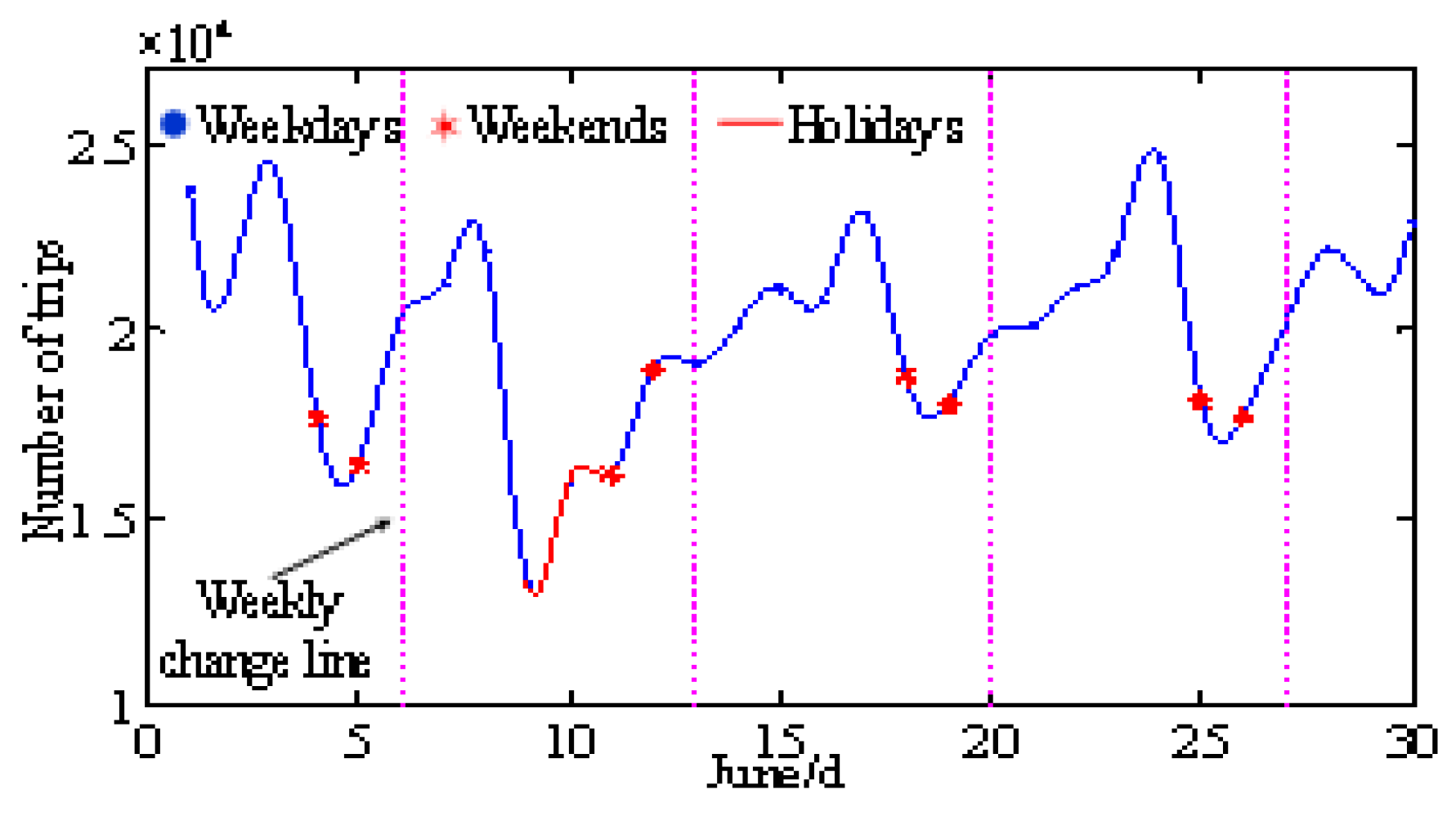
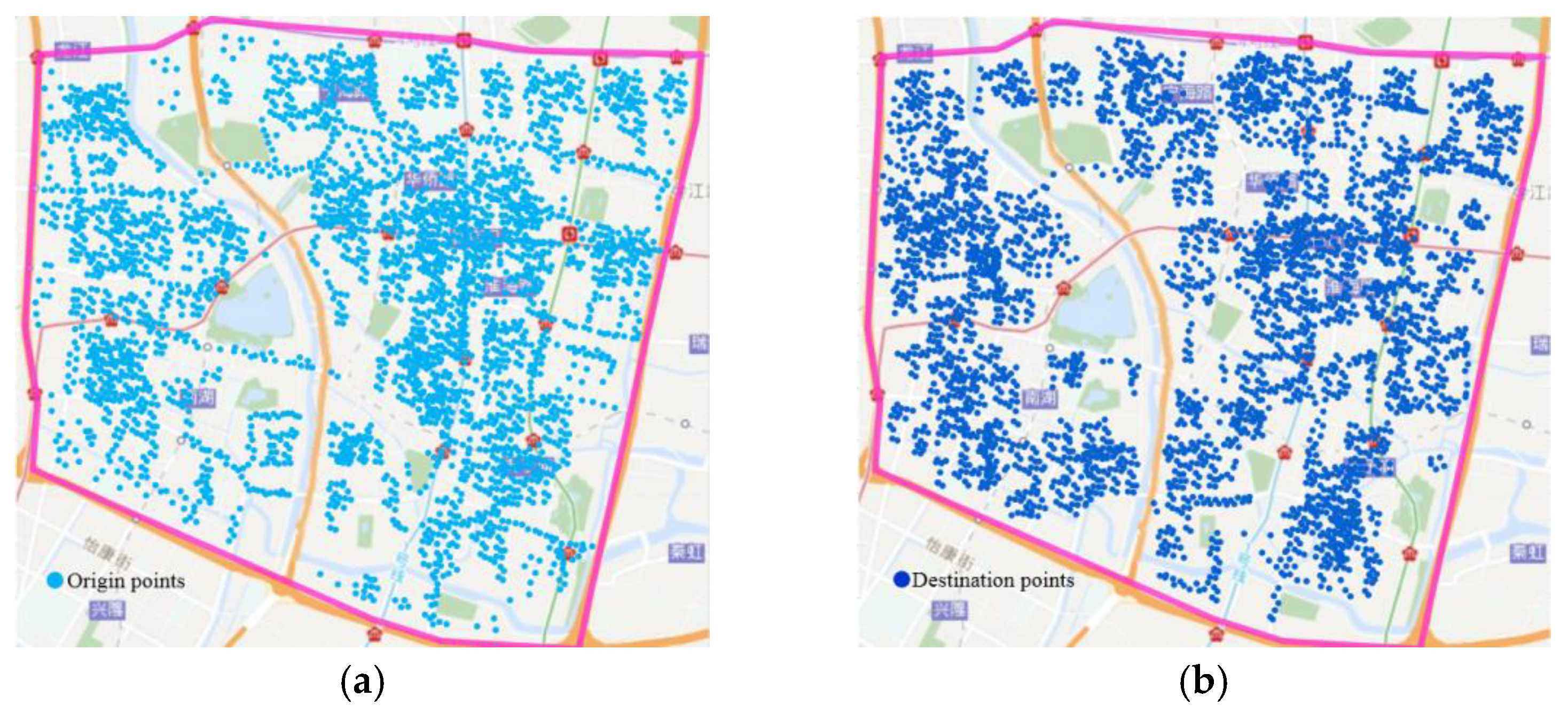
| FCS Number | Latitude/° | Longitude/° | Road Location | Functional Area |
|---|---|---|---|---|
| 1 | 32.0451 | 118.7894 | 234–281 | commercial area |
| 2 | 32.0497 | 118.7910 | 374–375 | commercial area |
| 3 | 32.0411 | 118.7938 | 391–565 | commercial area |
| 4 | 32.1034 | 118.9164 | 478–481 | industrial area |
| 5 | 32.0383 | 118.7962 | 433–567 | commercial area |
| 6 | 32.0526 | 118.8026 | 561–562 | industrial area |
| 7 | 32.0504 | 118.7984 | 568–569 | public service area |
| 8 | 32.0262 | 118.7990 | 342–359 | residential area |
| 9 | 32.0262 | 118.7990 | 490–492 | commercial area |
| 10 | 32.0195 | 118.7968 | 493–568 | industrial area |
| 11 | 32.0265 | 118.7500 | 120–122 | industrial area |
| 12 | 32.0448 | 118.7529 | 73–90 | residential area |
| 13 | 32.0247 | 118.7571 | 179–200 | residential area |
| 14 | 32.0646 | 118.7971 | 252–259 | public service area |
| Time Period | Path Method | Average Mileage/km | Average Time Consumption/min | Proportions of the First, Second and Third Road Grade/% | Running Time/s |
|---|---|---|---|---|---|
| 07:00–08:00 | AP | 9.66 | 25.15 | 44.33/28.79/26.88 | 24.22 |
| SLP | 7.23 | 35.77 | 48.56/24.55/26.89 | 5.23 | |
| STP | 10.89 | 19.12 | 40.95/28.77/30.28 | 19.27 | |
| 15:00–16:00 | AP | 8.63 | 20.43 | 40.22/34.42/25.36 | 17.26 |
| SLP | 7.23 | 18.55 | 48.56/24.55/26.89 | 5.67 | |
| STP | 9.56 | 15.56 | 36.89/32.66/30.45 | 12.22 | |
| 02:00–03:00 | AP | 7.83 | 15.56 | 45.23/31.12/23.65 | 13.19 |
| SLP | 7.23 | 21.78 | 48.56/24.55/26.89 | 4.99 | |
| STP | 8.15 | 14.89 | 43.22/28.55/28.23 | 10.12 |
| Input Data | Input Models | Output Results | |
|---|---|---|---|
| Case Study 1 | 1. Trip data on weekdays, weekends and holidays 2. Geographic position information of FCSs | 1. Single electric vehicle model 2. Human behavior decision-making model | Temporal–spatial distribution of fast charging demand load |
| Case Study 2 | 1. Trip data on weekdays 2. Geographic position information of FCSs 3. Charging price of FCSs | 1. Single electric vehicle model 2. Human behavior decision-making model 3. STP, SLP methods | Fast charging demand load with different path strategies |
| Case Study 3 | 1. Trip data on weekdays 2. Geographic position information of FCS1 3. Charging price of FCS1 | 1. Single electric vehicle model 2. Human behavior decision-making model 3. Different charging modes | Fast charging demand load with different charging modes |
| Case Study 4 | 1. Trip data on weekdays 2. Geographic position information of FCS1 | 1. Single electric vehicle model 2. Human behavior decision-making model 3. Different charging facility ratios | Fast charging demand load with different charging facility ratios |
| Case Study 5 | 1. Trip data on weekdays 2. Geographic position information of FCS1 3. Charging price of FCS1 | 1.Single electric vehicle model 2. Human behavior decision-making model with different parameters | Charging time consumption and charging cost |
References
- Du, J.; Ouyang, M.; Chen, J. Prospects for Chinese electric vehicle technologies in 2016–2020: Ambition and rationality. Energy 2017, 120, 584–596. [Google Scholar] [CrossRef]
- Liu, L.; Wang, K.; Wang, S.; Zhang, R.; Tang, X. Assessing energy consumption, CO2 and pollutant emissions and health benefits from China’s transport sector through 2050. Energy Policy 2018, 116, 382–396. [Google Scholar] [CrossRef]
- Cheng, X.; Hu, X.; Yang, L.; Husain, I.; Inoue, K.; Krein, P.; Wang, F.Y. Electrified vehicles and the smart grid: The ITS perspective. IEEE Trans. Intell. Transp. Syst. 2014, 15, 1388–1404. [Google Scholar] [CrossRef]
- Zheng, Y.; Niu, S.; Shang, Y.; Shao, Z.; Jian, L. Integrating plug-in electric vehicles into power grids: A comprehensive review on power interaction mode, scheduling methodology and mathematical foundation. Renew. Sustain. Energy Rev. 2019, 112, 424–439. [Google Scholar] [CrossRef]
- State Council of China. Plan of Energy Conservation and Development for New Energy Automobile Industry (2012–2020). 2012. Available online: http://www.nea.gov.cn/2012-07/10/c_131705726.htm (accessed on 7 October 2012).
- Ji, Z.; Huang, X. Plug-in electric vehicle charging infrastructure deployment of China towards 2020: Policies, methodologies, and challenges. Renew. Sustain. Energy Rev. 2018, 90, 710–727. [Google Scholar] [CrossRef]
- Wei, W.; Danman, W.U.; Qiuwei, W.U.; Shafie-Khah, M.; Catalao, J.P. Interdependence between transportation system and power distribution system: A comprehensive review on models and applications. J. Mod. Power Syst. Clean Energy 2019, 7, 433–448. [Google Scholar] [CrossRef]
- Carli, R.; Dotoli, M. A distributed control algorithm for optimal charging of electric vehicle fleets with congestion management. IFAC-Pap. 2018, 51, 373–378. [Google Scholar] [CrossRef]
- Sun, Y.; Chen, Z.; Li, Z.; Tian, W.; Shahidehpour, M. EV charging schedule in coupled constrained networks of transportation and power system. IEEE Trans. Smart Grid 2018, 10, 4706–4716. [Google Scholar] [CrossRef]
- Muratori, M. Impact of uncoordinated plug-in electric vehicle charging on residential power demand. Nat. Energy 2018, 3, 193–201. [Google Scholar] [CrossRef]
- Ma, Z.; Callaway, D.S.; Hiskens, I.A. Decentralized charging control of large populations of plug-in electric vehicles. IEEE Trans. Control Syst. Technol. 2011, 21, 67–78. [Google Scholar] [CrossRef]
- Carli, R.; Dotoli, M.; Epicoco, N.; Angelico, B.; Vinciullo, A. Automated evaluation of urban traffic congestion using bus as a probe. In Proceedings of the 2015 IEEE International Conference on Automation Science and Engineering (CASE), Gothenburg, Sweden, 24–28 August 2015; pp. 967–972. [Google Scholar]
- Chen, T.; Zhang, B.; Pourbabak, H.; Kavousi-Fard, A.; Su, W. Optimal routing and charging of an electric vehicle fleet for high-efficiency dynamic transit systems. IEEE Trans. Smart Grid 2018, 9, 3563–3572. [Google Scholar] [CrossRef]
- Luo, Y.; Zhu, T.; Wan, S.; Zhang, S.; Li, K. Optimal charging scheduling for large-scale EV (electric vehicle) deployment based on the interaction of the smart-grid and intelligent-transport systems. Energy 2016, 97, 359–368. [Google Scholar] [CrossRef]
- Tang, D.; Wang, P. Probabilistic modeling of nodal charging demand based on spatial-temporal dynamics of moving electric vehicles. IEEE Trans. Smart Grid 2016, 7, 627–636. [Google Scholar] [CrossRef]
- Shun, T.; Kunyu, L.; Xiangning, X.; Jianfeng, W.; Yang, Y.; Jian, Z. Charging demand for electric vehicle based on stochastic analysis of trip chain. IET Gener. Transm. Distrib. 2016, 10, 2689–2698. [Google Scholar] [CrossRef]
- Wang, Y.; Infield, D. Markov Chain Monte Carlo simulation of electric vehicle use for network integration studies. Int. J. Electr. Power Energy Syst. 2018, 99, 85–94. [Google Scholar] [CrossRef]
- Su, S.; Zhao, H.; Zhang, H.; Lin, X.; Yang, F.; Li, Z. Forecast of electric vehicle charging demand based on traffic flow model and optimal path planning. In Proceedings of the 2017 19th International Conference on Intelligent System Application to Power Systems (ISAP), San Antonio, TX, USA, 17–20 September 2017; pp. 1–6. [Google Scholar]
- Van der Wardt, T.; Farid, A. A hybrid dynamic system assessment methodology for multi-modal transportation-electrification. Energies 2017, 10, 653. [Google Scholar] [CrossRef]
- Guo, Q.; Xin, S.; Sun, H.; Li, Z.; Zhang, B. Rapid-charging navigation of electric vehicles based on real-time power systems and traffic data. IEEE Trans. Smart Grid 2014, 5, 1969–1979. [Google Scholar] [CrossRef]
- Mu, Y.; Wu, J.; Jenkins, N.; Wang, C. A spatial–temporal model for grid impact analysis of plug-in electric vehicles. Appl. Energy 2014, 114, 456–465. [Google Scholar] [CrossRef]
- Jia, Y.; Chen, H.; Li, J.; He, F.; Li, M.; Hu, Z.; Shen, Z. Planning for electric taxi charging system from the perspective of transport energy supply chain: A data-driven approach in Beijing. In Proceedings of the 2017 IEEE Transportation Electrification Conference and Expo, Asia-Pacific (ITEC Asia-Pacific), Harbin, China, 7–10 August 2017; pp. 1–6. [Google Scholar]
- Cai, H.; Jia, X.; Chiu, A.S.F.; Hu, X.; Xu, M. Siting public electric vehicle charging stations in Beijing using big-data informed travel patterns of the taxi fleet. Transp. Res. Part D Transp. Environ. 2014, 33, 39–46. [Google Scholar] [CrossRef]
- Ashtari, A.; Bibeau, E.; Shahidinejad, S.; Molinski, T. PEV charging profile prediction and analysis based on vehicle usage data. IEEE Trans. Smart Grid 2011, 3, 341–350. [Google Scholar] [CrossRef]
- Dalla Chiara, B.; Deflorio, F.; Eid, M. Analysis of real driving data to explore travelling needs in relation to hybrid—Electric vehicle solutions. Transp. Policy 2019, 80, 97–116. [Google Scholar] [CrossRef]
- Tseng, C.M.; Chau, S.C.K.; Liu, X. Improving viability of electric taxis by taxi service strategy optimization: A big data study of New York City. IEEE Trans. Intell. Transp. Syst. 2018, 20, 817–829. [Google Scholar] [CrossRef]
- Arias, M.B.; Bae, S. Electric vehicle charging demand forecasting model based on big data technologies. Appl. Energy 2016, 183, 327–339. [Google Scholar] [CrossRef]
- Arias, M.B.; Kim, M.; Bae, S. Prediction of electric vehicle charging-power demand in realistic urban traffic networks. Appl. Energy 2017, 195, 738–753. [Google Scholar] [CrossRef]
- Hilton, G.; Kiaee, M.; Bryden, T.; Dimitrov, B.; Cruden, A.; Mortimer, A. A Stochastic Method for Prediction of the Power Demand at High Rate EV Chargers. IEEE Trans. Transp. Electrif. 2018, 4, 744–756. [Google Scholar] [CrossRef]
- Xydas, E.; Marmaras, C.; Cipcigan, L.M.; Jenkins, N.; Carroll, S.; Barker, M. A data-driven approach for characterising the charging demand of electric vehicles: A UK case study. Appl. Energy 2016, 162, 763–771. [Google Scholar] [CrossRef]
- Li, M.; Lenzen, M.; Keck, F.; McBain, B.; Rey-Lescure, O.; Li, B.; Jiang, C. GIS-based probabilistic modeling of BEV charging load for Australia. IEEE Trans. Smart Grid 2018, 10, 3525–3534. [Google Scholar] [CrossRef]
- Jahangir, H.; Tayarani, H.; Ahmadian, A.; Golkar, M.A.; Miret, J.; Tayarani, M.; Gao, H.O. Charging demand of Plug-in Electric Vehicles: Forecasting travel behavior based on a novel Rough Artificial Neural Network approach. J. Clean. Prod. 2019, 229, 1029–1044. [Google Scholar] [CrossRef]
- Li, W.; Lin, Z.; Zhou, H.; Golkar, M.A.; Miret, J.; Tayarani, M.; Gao, H.O. Multi-Objective Optimization for Cyber-Physical-Social Systems: A Case Study of Electric Vehicles Charging and Discharging. IEEE Access 2019, 7, 76754–76767. [Google Scholar] [CrossRef]
- Chaudhari, K.; Kandasamy, N.K.; Krishnan, A.; Ukil, A.; Gooi, H.B. Agent-Based Aggregated Behavior Modeling for Electric Vehicle Charging Load. IEEE Trans. Ind. Inform. 2018, 15, 856–868. [Google Scholar] [CrossRef]
- Jiejun, C. Analysis of Electric Vehicle Load Characteristics and Research on Orderly Charging Strategy; Wuhan University: Wuhan, China, 2018. [Google Scholar]
- Yang, T.; Xu, X.; Guo, Q.; Zhang, L.; Sun, H. EV charging behaviour analysis and modelling based on mobile crowdsensing data. IET Gener. Transm. Distrib. 2017, 11, 1683–1691. [Google Scholar] [CrossRef]
- Qiang, X.; Chen, Z.; Zhang, Q.; Huang, X.; Leng, Z.; Sun, K.; Wang, H. Charging Demand Forecasting Model for Electric Vehicles Based on Online Ride-Hailing Trip Data. IEEE Access 2019, 7, 137390–137409. [Google Scholar]
- Sui, Y.; Zhang, H.; Song, X.; Shao, F.; Yu, X.; Shibasaki, R.; Li, Y. GPS data in urban online ride-hailing: A comparative analysis on fuel consumption and emissions. J. Clean. Prod. 2019, 227, 495–505. [Google Scholar] [CrossRef]
- Wang, Y.; Xu, D.; Peng, P.; Xuan, Q.; Zhang, G. Analysis of Hospitalizing Behaviors Based on Big Trajectory Data. IEEE Trans. Comput. Soc. Syst. 2019, 6, 692–701. [Google Scholar] [CrossRef]
- Tu, W.; Santi, P.; Zhao, T.; He, X.; Li, Q.; Dong, L.; Ratti, C. Acceptability, energy consumption, and costs of electric vehicle for ride-hailing drivers in Beijing. Appl. Energy 2019, 250, 147–160. [Google Scholar] [CrossRef]
- Sun, D.J.; Zhang, K.; Shen, S. Analyzing spatiotemporal traffic line source emissions based on massive didi online car-hailing service data. Transp. Res. Part D Transp. Environ. 2018, 62, 699–714. [Google Scholar] [CrossRef]
- Herrera, J.C.; Work, D.B.; Herring, R.; Ban, X.J.; Jacobson, Q.; Bayen, A.M. Evaluation of traffic data obtained via GPS-enabled mobile phones: The Mobile Century field experiment. Transp. Res. Part C Emerg. Technol. 2010, 18, 568–583. [Google Scholar] [CrossRef]
- Yao, E.; Yang, Z.; Song, Y.; Zuo, T. Comparison of Electric Vehicle’s Energy Consumption Factors for Different Road Types. Discret. Dyn. Nat. Soc. 2013, 2013. [Google Scholar] [CrossRef]
- Ruqi, L.; Haoyi, S. Optimal allocation of charging facilities for electric vehicles basedon queuing theory. Autom. Electr. Power Syst. 2011, 35, 58–61. [Google Scholar]
- Chorus, C.G. A new model of random regret minimization. Eur. J. Transp. Infrastruct. Res. 2010, 10. [Google Scholar] [CrossRef]
- Bell, D.E. Regret in decision making under uncertainty. Oper. Res. 1982, 30, 961–981. [Google Scholar] [CrossRef]
- Li, M.; Huang, H.J. A regret theory-based route choice model. Transp. A Transp. Sci. 2017, 13, 250–272. [Google Scholar] [CrossRef]




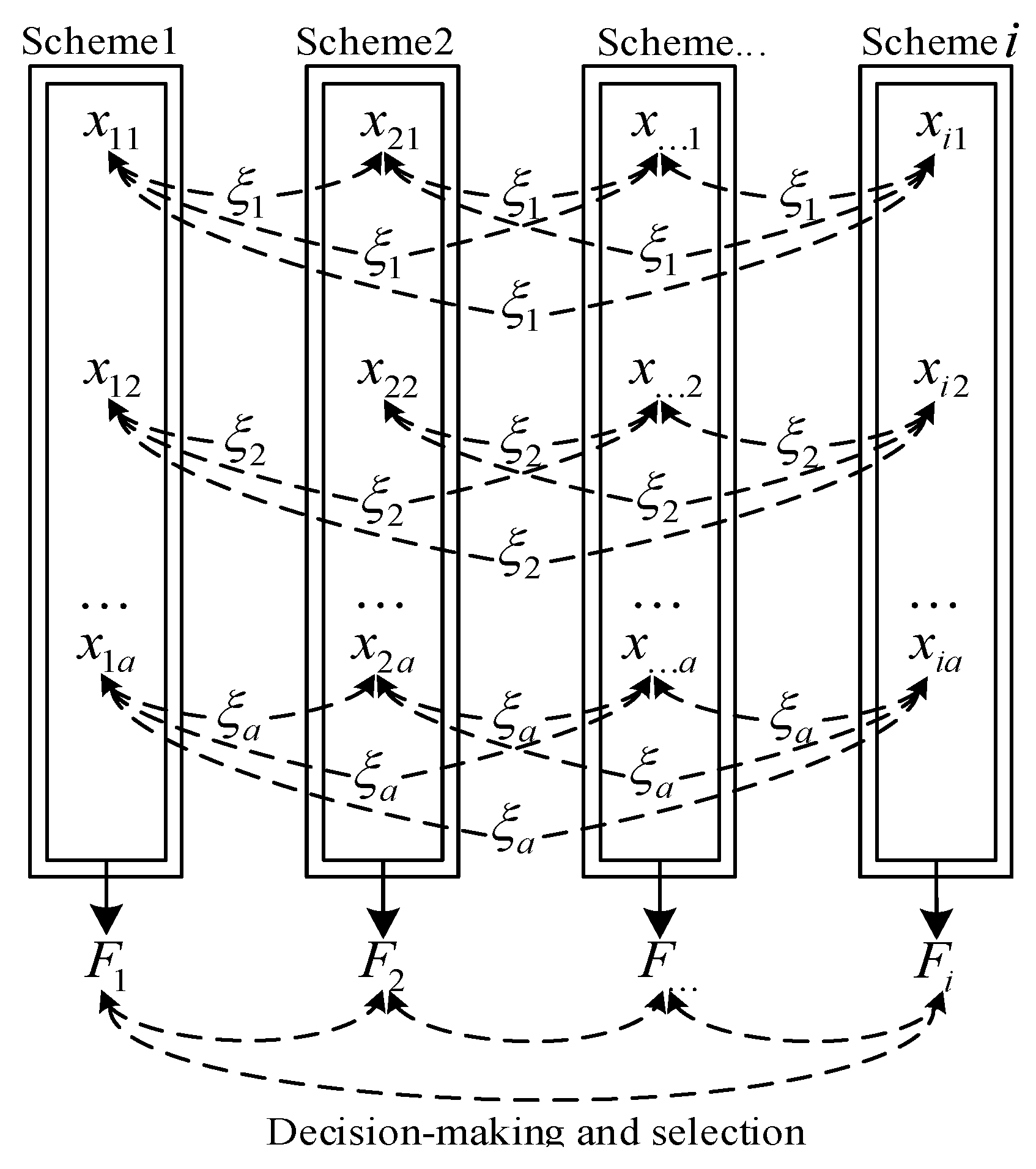
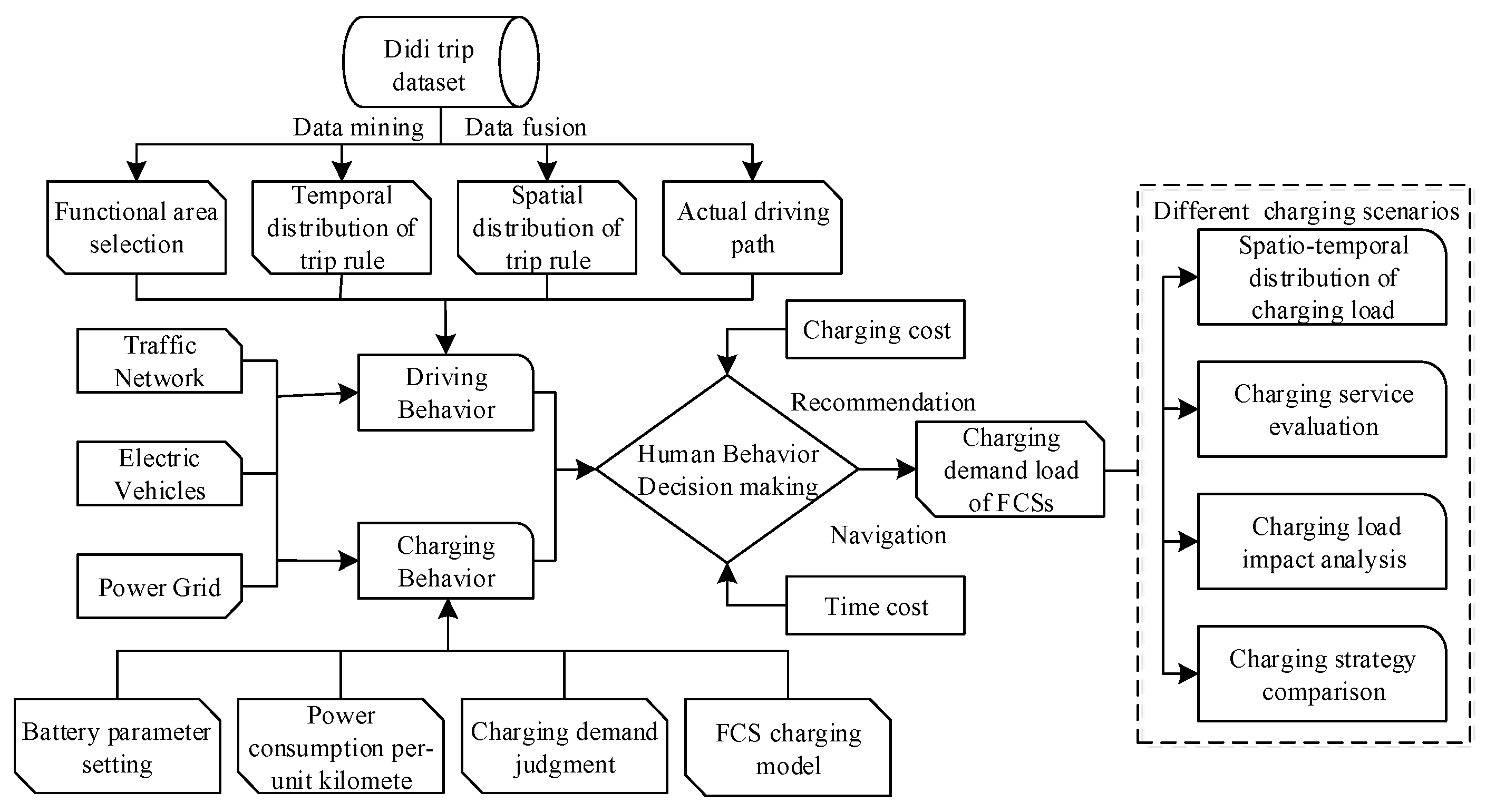

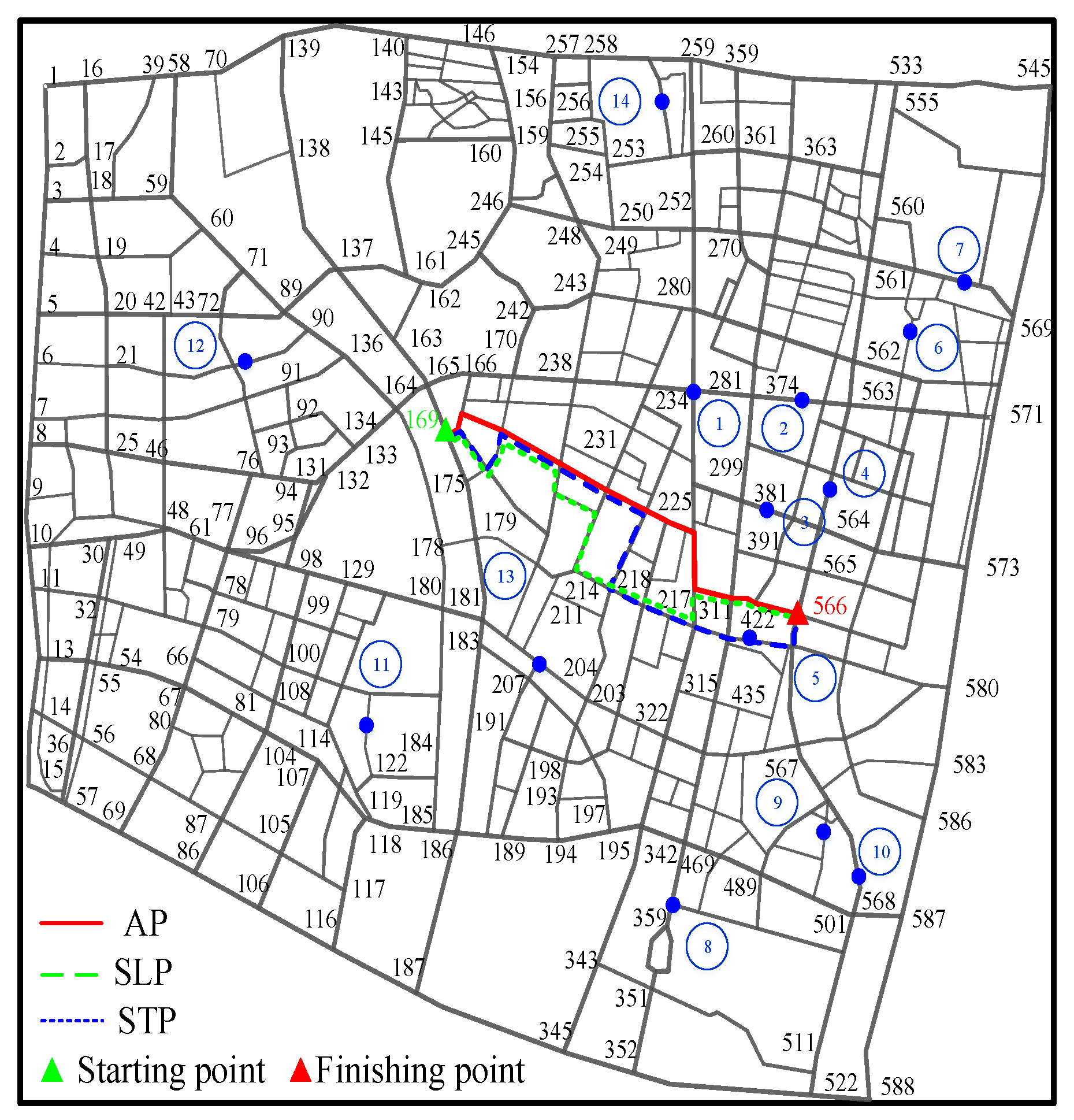
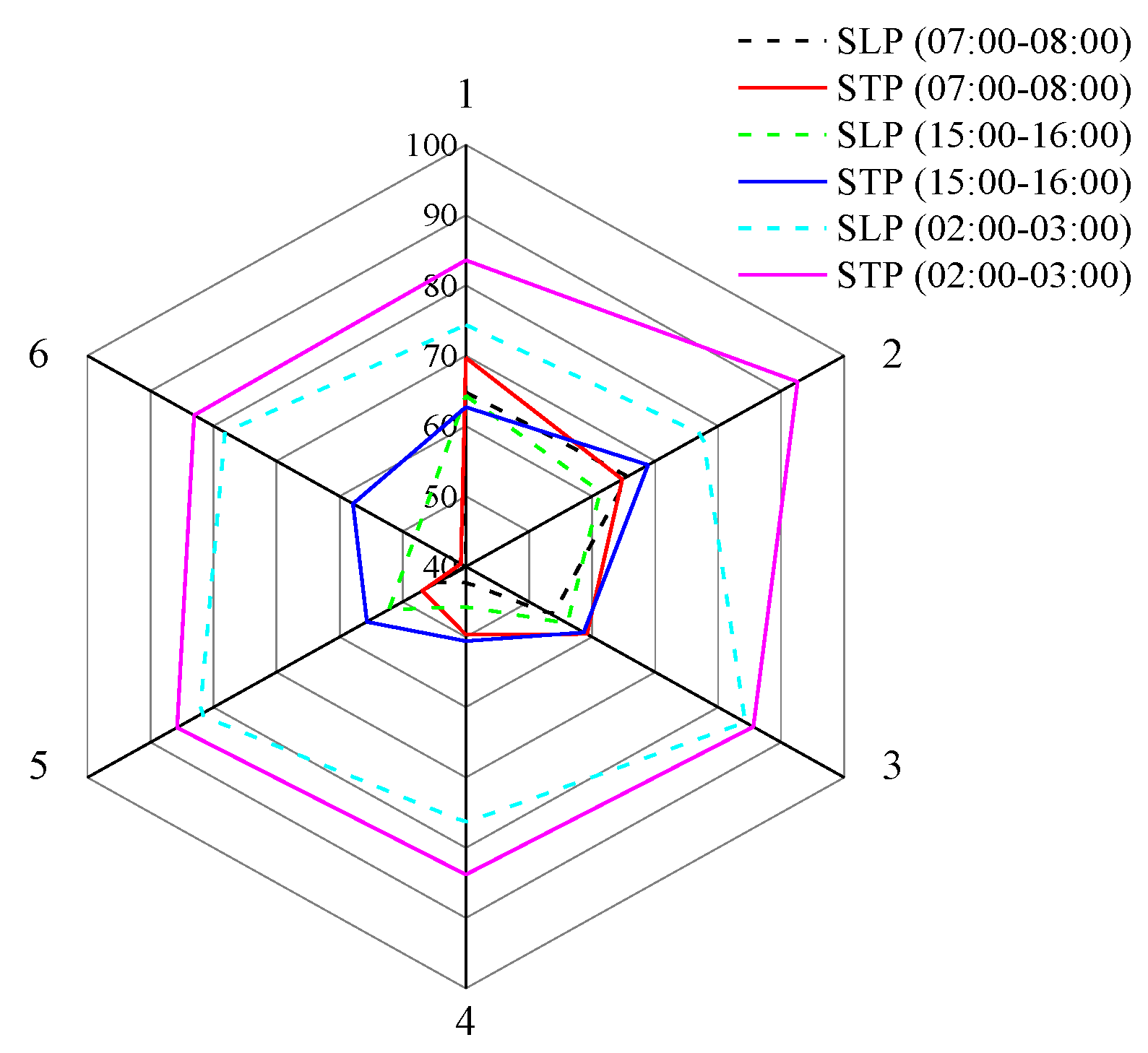
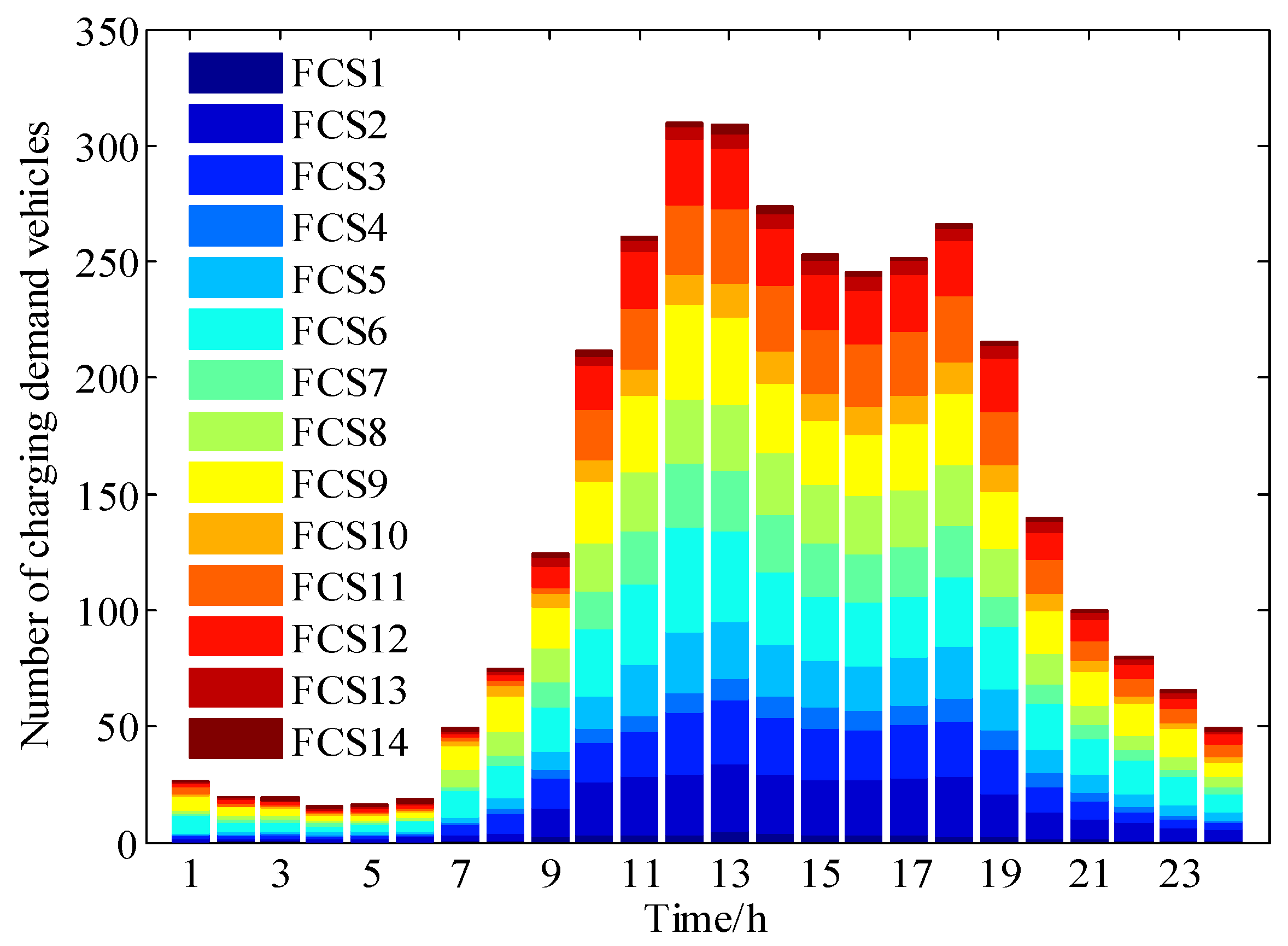
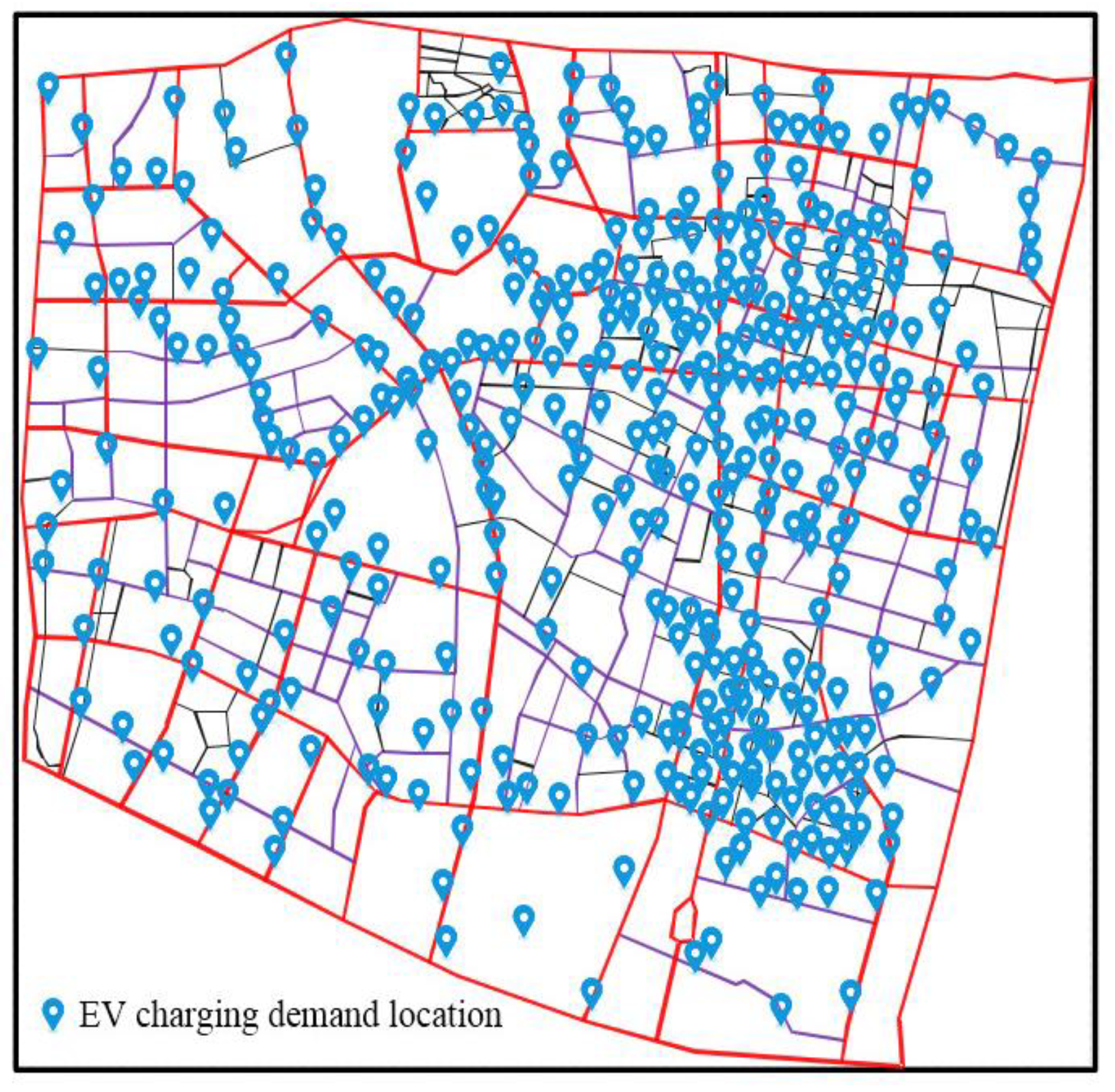

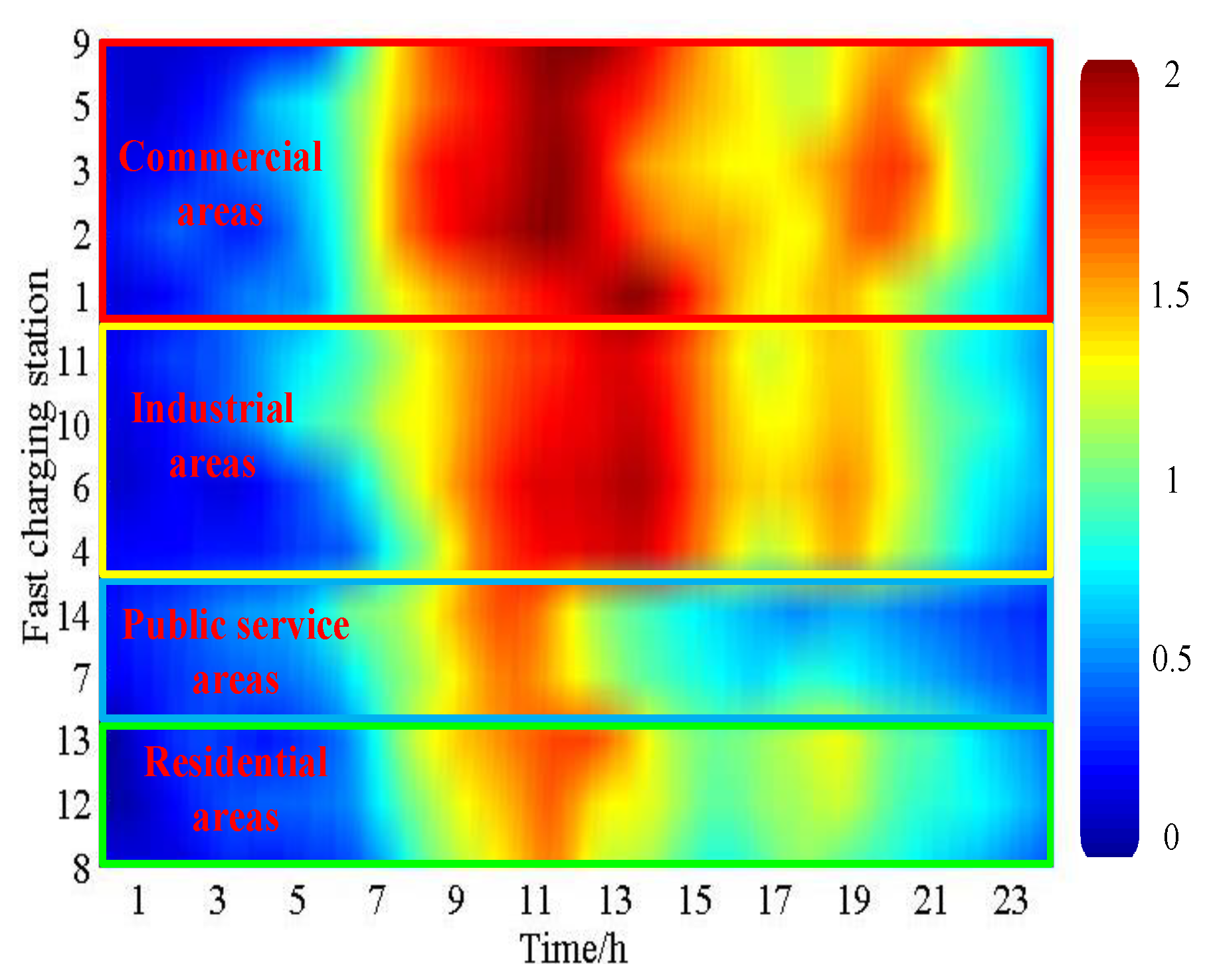
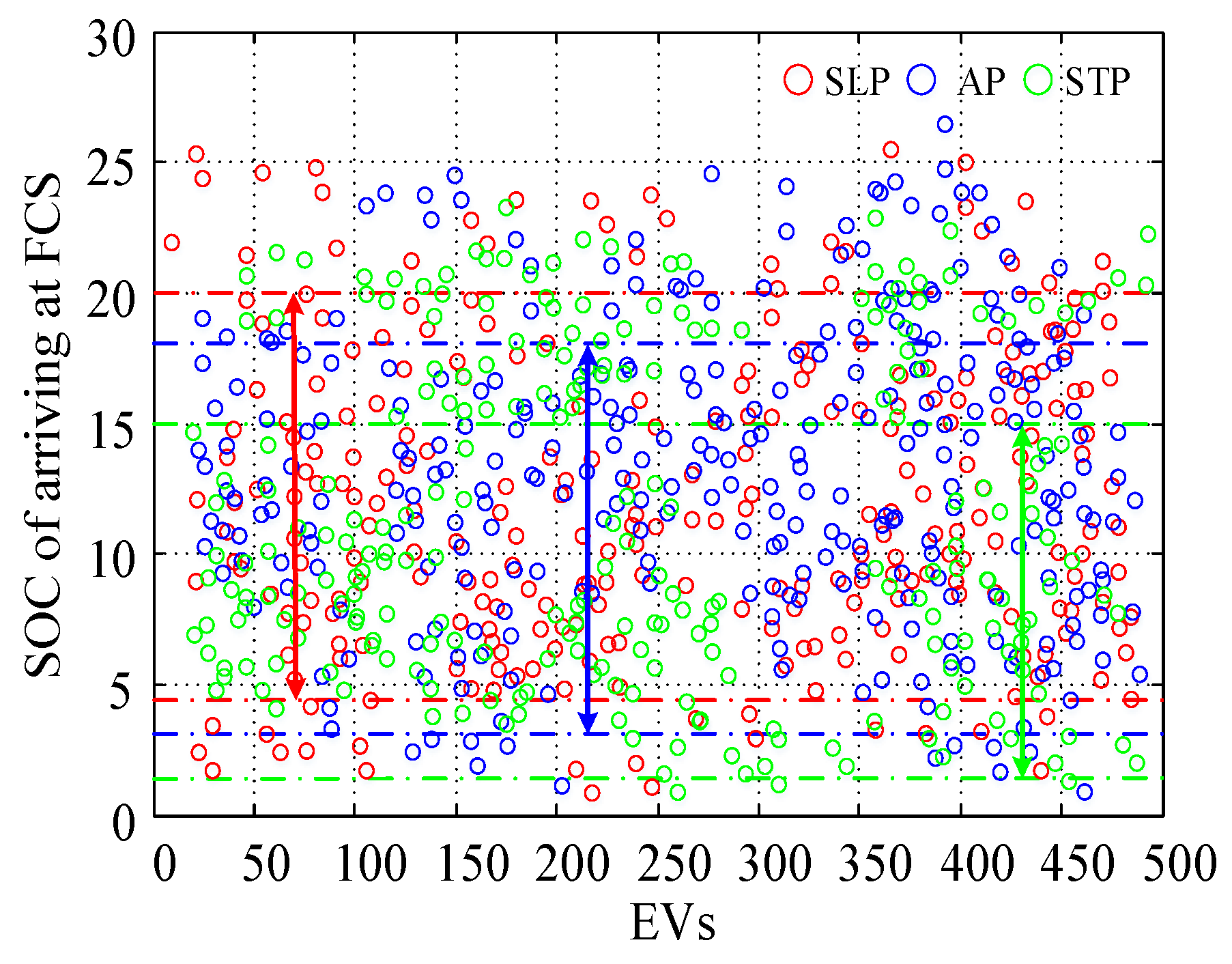
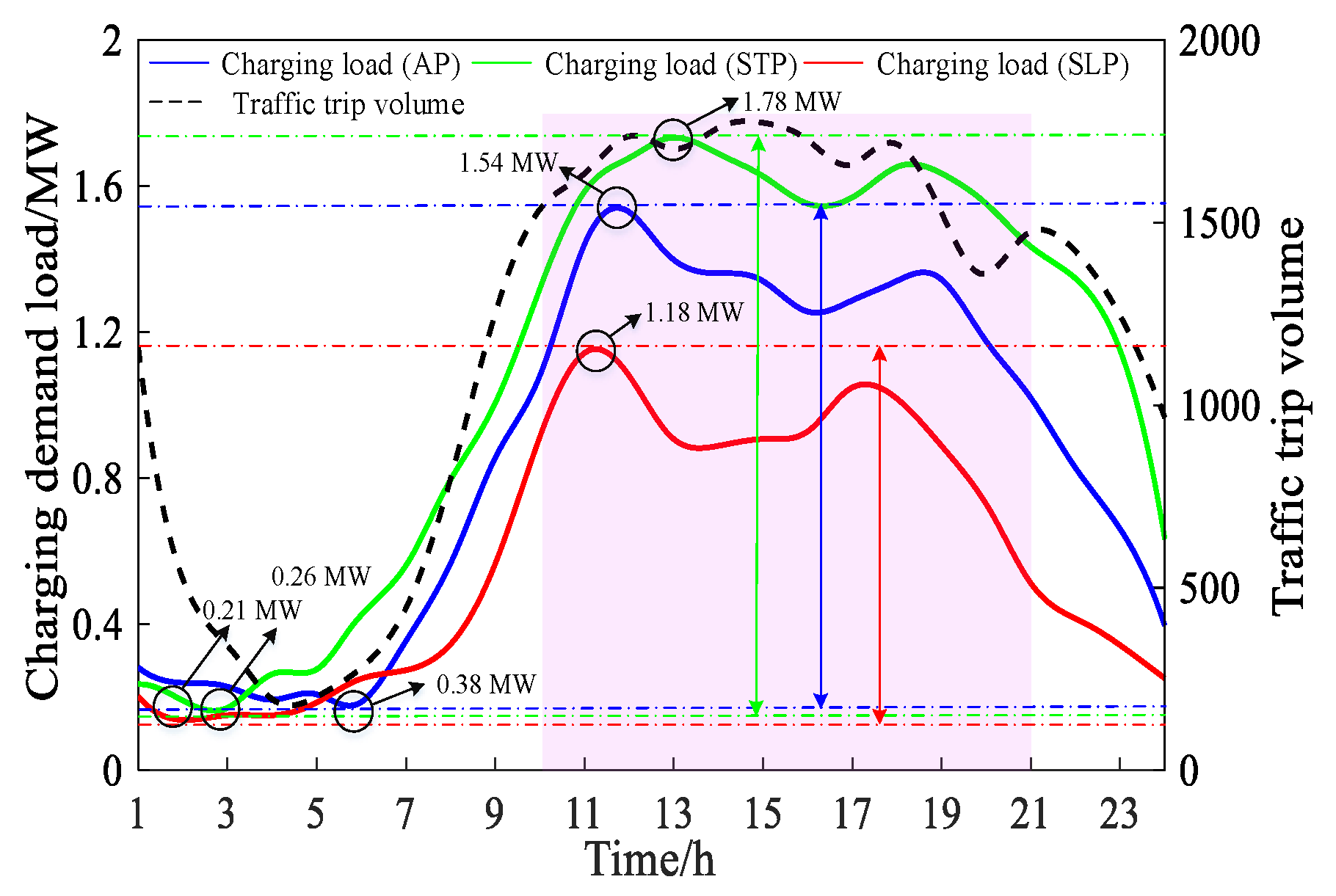
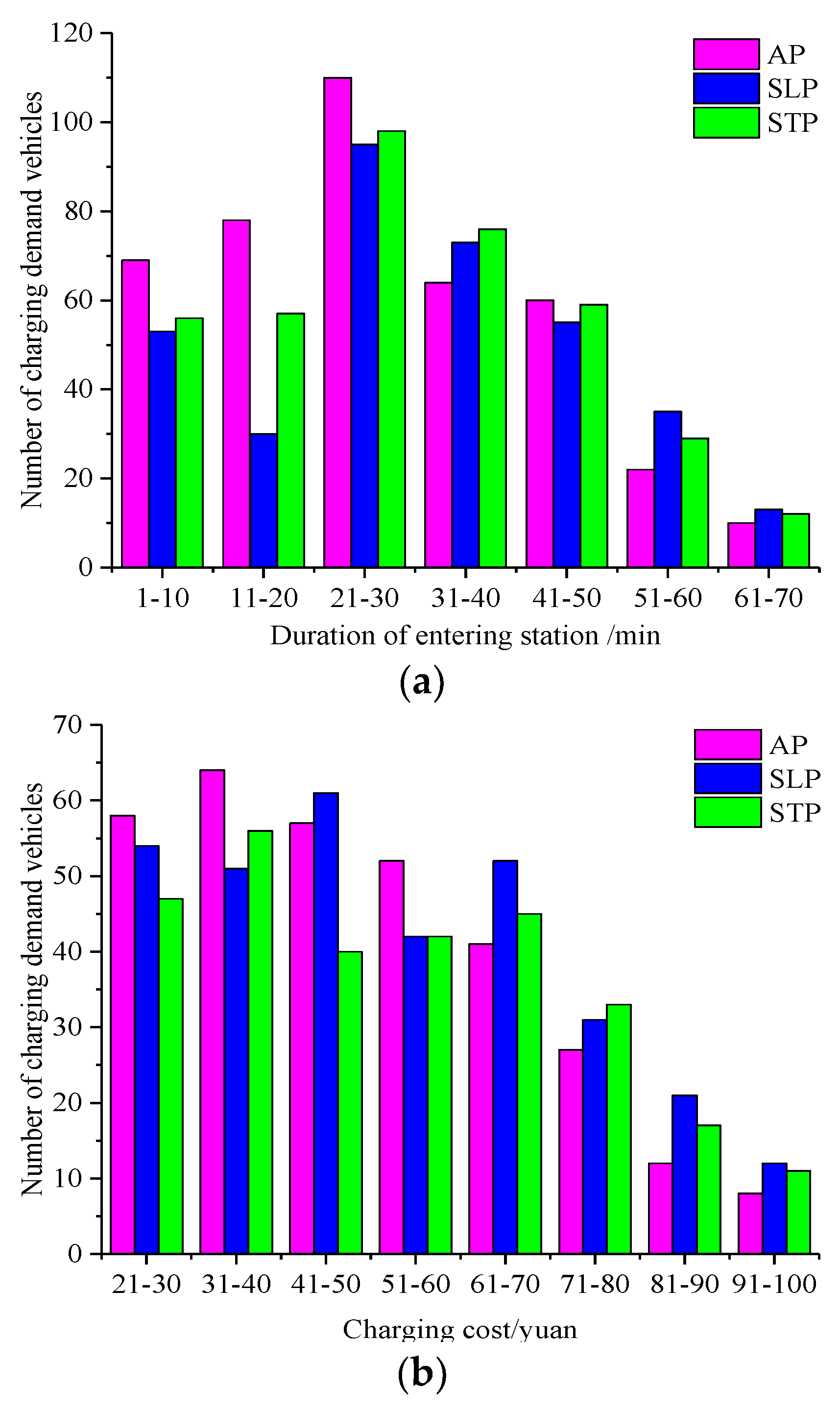

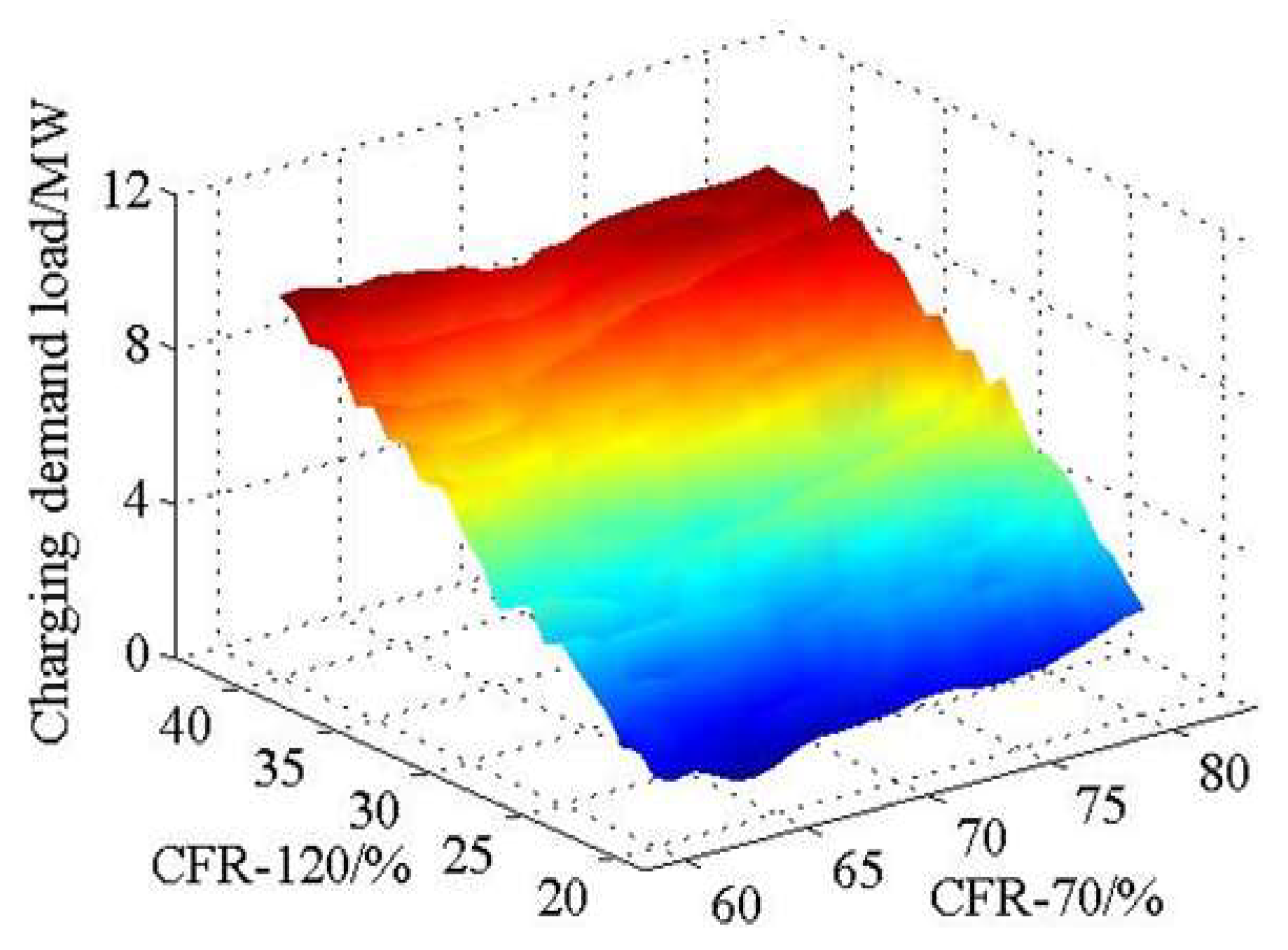



| Date Type | Peak Load/MW | Valley Load/MW | Running Time/s |
|---|---|---|---|
| Weekdays | 1.56 (FCS1) | 0.07 (FCS11) | 467.23 |
| Weekends | 1.42 (FCS1) | 0.06 (FCS12) | 423.22 |
| Holidays | 1.23 (FCS2) | 0.07 (FCS11) | 366.23 |
| Path Strategy | Average Charging Duration/min | Average Charging Cost/yuan | Time Interval with the Most Vehicles Entering Station/min | Maximum Charging Cost Range/yuan | Average Running Time/s |
|---|---|---|---|---|---|
| AP | 21.37 | 45.23 | 21–30 | 31–40 | 34.56 |
| SLP | 24.87 | 41.28 | 21–30 | 41–50 | 12.11 |
| STP | 29.78 | 51.23 | 21–30 | 31–40 | 24.49 |
| Charging Mode | Average Load/MW | Average Charging Duration/min | Average Waiting Time/min | Average Charging Cost/yuan |
|---|---|---|---|---|
| M1 | 1.18 | 21.25 | 19.32 | 48.32 |
| M2 | 0.56 | 17.55 | 11.89 | 32.59 |
| M3 | 0.63 | 15.36 | 12.15 | 34.12 |
| M4 | 0.68 | 16.63 | 13.55 | 36.78 |
| Scenario | Charging Duration/min | Charging Cost/yuan | Average Load/MW | ||
|---|---|---|---|---|---|
| S1 | 0.5 | 0.5 | 46.9 | 60.3 | 0.68 |
| S2 | 1.0 | 0.5 | 42.9 | 62.3 | 0.49 |
| S3 | 0.5 | 1.0 | 44.5 | 58.3 | 0.53 |
| S4 | 1.0 | 1.0 | 48.9 | 54.3 | 0.56 |
| S5 | 0.5 | 1.5 | 43.2 | 56.3 | 0.65 |
| S6 | 1.0 | 1.5 | 37.8 | 46.8 | 0.72 |
© 2020 by the authors. Licensee MDPI, Basel, Switzerland. This article is an open access article distributed under the terms and conditions of the Creative Commons Attribution (CC BY) license (http://creativecommons.org/licenses/by/4.0/).
Share and Cite
Xing, Q.; Chen, Z.; Zhang, Z.; Xu, X.; Zhang, T.; Huang, X.; Wang, H. Urban Electric Vehicle Fast-Charging Demand Forecasting Model Based on Data-Driven Approach and Human Decision-Making Behavior. Energies 2020, 13, 1412. https://doi.org/10.3390/en13061412
Xing Q, Chen Z, Zhang Z, Xu X, Zhang T, Huang X, Wang H. Urban Electric Vehicle Fast-Charging Demand Forecasting Model Based on Data-Driven Approach and Human Decision-Making Behavior. Energies. 2020; 13(6):1412. https://doi.org/10.3390/en13061412
Chicago/Turabian StyleXing, Qiang, Zhong Chen, Ziqi Zhang, Xiao Xu, Tian Zhang, Xueliang Huang, and Haiwei Wang. 2020. "Urban Electric Vehicle Fast-Charging Demand Forecasting Model Based on Data-Driven Approach and Human Decision-Making Behavior" Energies 13, no. 6: 1412. https://doi.org/10.3390/en13061412
APA StyleXing, Q., Chen, Z., Zhang, Z., Xu, X., Zhang, T., Huang, X., & Wang, H. (2020). Urban Electric Vehicle Fast-Charging Demand Forecasting Model Based on Data-Driven Approach and Human Decision-Making Behavior. Energies, 13(6), 1412. https://doi.org/10.3390/en13061412




